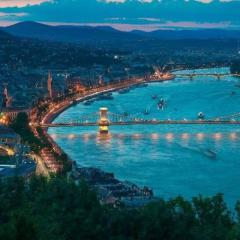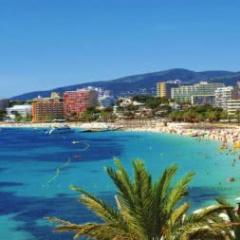The lake with the clearest water. The cleanest and most transparent lake in the world. New discovery by scientists
Sometimes Mother Nature is unable to protect her creations from human hands. And now, when the issue of ecology is especially acute, it is very difficult to believe that there are still untouched corners of the planet, nature reserves or clean lakes left on earth. But they exist. Man has had a hand in the disappearance of some species of animals and plants and even entire ecosystems. And now it is very important to preserve what is left! It is very important to start treating the world around us more carefully!
Oddly enough, there are quite a large number of clean lakes left in the world, and it is very difficult to get to know them in one article. Therefore, below, we will consider only a few of the cleanest lakes in the world, distinguished by water of special quality.
Lake New Zealand
Blue Lake is located in Nelson Lakes National Park, New Zealand. It was not by chance that it got to the top of the ranking of the cleanest lakes in the world, because it can be seen to a depth of almost 80 meters! It is prohibited not only to fish, but also to swim. And in order for photographer Klaus Thiemann to be able to immerse himself in it for a photo report, he had to negotiate not only with the government, but also with the local Maori tribe, for whom the lake is sacred.
The deepest and cleanest lake in the world - Baikal
You, of course, guessed that in this part we will talk about the cleanest lake in Russia - Baikal. This lake can rightfully be considered the most unique, because it contains about 20% of the world's fresh water, its depth is more than 1.5 km, and it is home to about 3,000 species and subspecies of plants and animals, and 805 of them are not found anywhere else in any corner of the planet. It is also noteworthy that the shores of this lake increase by 2 cm every year.
The waters of Baikal can be seen at different times of the year to an average depth of 40 m. More than 300 rivers flow into this lake, and only one flows out of it - the Angara, the daughter of Baikal, which, although not included in the number, flows into the river from of this list - Yenisei.

Until recently, its purity was under threat, because a pulp and paper mill operated on the territory adjacent to the lake. Scientists regularly took water samples and were horrified that the content of dioxins, which are a strong poison for many living beings, was gradually increasing in the waters of Lake Baikal. Only in 2013 the plant ceased operations. Now in its place it is planned to create the Expo Center “Reserves of Russia”.
Lake of Five Flowers
Lake of Five Flowers is located in China, in the very center of the Jiuzhaigou Valley. Its uniqueness lies not only in the incredible purity of the water, but also in the fact that its color changes from time to time: from yellow to dark green, although most of the time the water is diamond blue.

It can be safely included in . In its vicinity there are several more lakes and waterfalls. All of them freeze in winter, but only the Lake of Five Flowers is not frozen. Scientists explain this by the presence of hot springs at its depth, although so far no one has been able to detect a single source due to the tree trunks covering the bottom of the lake. The waters of this lake, like those of Lake Baikal, can be seen to a depth of 40 m.
Peyto Lake, Canada
High in the mountains, surrounded by rocky peaks, lies Peyto Lake. Without a doubt, it can be included in the list of the most beautiful colored lakes in the world. It has a bright turquoise color, which appears especially bright in photographs under the midday sun.

In the vicinity of this fabulous lake there are many tourist centers, as well as many trails through which you can explore the local beauty.
Lake Hokkaido, Japan
The ranking of the cleanest lakes in the world cannot do without mentioning the Blue Pond, located on the Japanese island of Hokkaido. This lake was formed not so long ago, in 1989, after the eruption of the Tokachi volcano, when a dam was built to protect against volcanic flows. This is where the lake was formed.


The water in Lake Hokkaido comes from hot springs saturated with aluminum salts, which, when reflected in sunlight, make the water of the lake turquoise blue.
Crater Lake, USA
Crater Lake was formed as a result of the eruption of Mount Mazama in the crater of the volcano itself 7,700 years ago. Thanks to its uniqueness, a national park was created in this area, and now many tourists come here to enjoy the fabulous beauty of these places.
This lake is considered the deepest lake in the world, the waters of which are above sea level. Since 2005, the US Mint even began to issue a coin with the image of this wonderful lake.

Only one thing is alarming - hydrothermal activity is occurring on the Crater, indicating that the Mazam volcano may awaken again.
Lake Sheosar, Pakistan
The smooth slopes of the hills and plains surrounding the pristine Lake Sheosar attract crowds of tourists. This lake is located in Pakistan's Deosai National Park, in the north of the country.
The cleanest lakes in Europe
Among the cleanest lakes in Europe are the lakes of the Rhône-Alpes region, France. The total area of the lakes is 35 thousand hectares. The most popular among tourists is Lake Geneva (it is considered the inland sea of the country), Lake Annecy and Lake Aigblett are no less popular - these are truly corners of peace and serenity.
Bavaria can also please you with the cleanliness of its fresh waters. Here, the cleanest and most popular is Lake Chiemsee, on the shore of which the castle of Louis II is located. The surroundings of this clean lake can charm any tourist.
September 18 is World Water Quality Monitoring Day. This day is intended to remind society about the problems of water pollution throughout the world. Everyone is invited to conduct a series of simple tests to determine the water quality of local reservoirs, and publish the results on the World Water Quality Monitoring Day website. (pictured: Lake Königssee, Germany. Open sources)
In this post we remember the 3 cleanest bodies of water in the world.
1. Baikal (Russia)

And we will start with such a lake as dear to the Russian heart as Baikal. This miracle of Russia is located in the southern part of Eastern Siberia. Baikal can without a doubt be considered one of the deepest and cleanest lakes in the world! The area is 31,722 km², and the average depth is 744 m. The water here is very clear - at certain times of the year the transparency reaches 40 meters. ( photo: open sources)
2. Lake of Five Flowers (China)

Local residents say about this lake, located in Sichuan province, like this: “Nothing on earth can compare with Jiuzhaigou.” The water in the lake is so clean that you can see the trunks of fallen trees at the bottom. The water acquires its specific color, which changes depending on the time of year, thanks to mineral salts and aquatic plants. ( photo: open sources)
3. Lake Königssee (Germany)

This lake, 7.7 km long and with an area of 5.22 km², is located in the southeast of Bavaria and belongs to the Berchtesgaden National Park. Formed as a result of melting glaciers. Königssee is one of the three deepest lakes in Germany (average depth - 98 meters). The places themselves are a real paradise for a photographer! The surrounding mountains create stunning scenery. ( photo: open sources)
The first thought that arises when looking at this stunning body of water is to jump into its crystal clear water and splash around in it until exhausted.
The cleanest and at the same time the most beautiful lake on our planet is called Blue Lake and is located on the South Island of New Zealand. The first thought that arises when looking at this stunning body of water is to jump into its crystal clear water and splash around in it until exhausted. But, unfortunately, this is strictly prohibited!
Incomparable landscape. New Zealand's South Island is home to the last untouched wilderness.
Relict forests, steep cliffs and waterfalls - a stunning landscape.

There, deep in the mountains, lies the cleanest lake on Earth, fed by the purest water source.

Blue Lake (or in the Maori language - the indigenous people of New Zealand - Rotomairewhenua) is located in the Nelson Lakes National Park on the South Island.

The water there is so clear that when diving you can see far in front of you.

Laboratory tests have shown that the visibility range is from seventy meters.

For comparison: in distilled water this figure is about eighty meters.

This photograph shows that the water in the lake is so clear that it cannot be distinguished from the air.

Due to nature conservation reasons, swimming in the lake is prohibited.

Only scientists can obtain special permission to dive into the lake to take photographs such as these.
There are not many places left on our planet where you can find truly clean sources of water. We present to your attention a selection of 10 places with the cleanest and most transparent water on our planet.
The Maldives is a favorite destination for tourists from all over the world. The water here is so clear that while in a boat, you can see your shadow at the bottom of the sea.


The water in this red stone cave is surprisingly clear. The only thing that distorts the view of the bottom is the slight ripples caused by the nearby waterfall.

There is a unique lake in the Jiuzhaigou Valley in the northern Chinese province of Sichuan. It is famous for its bottom, covered with a carpet of ancient trees that can be seen through the clear water.

Another popular place among tourists, you don’t even need to describe anything here, just look at the photo.

Crater Lake is located in Oregon. Scientists suggest that it was formed as a result of the explosion of an ancient volcano about 7 thousand years ago.

Piccaninnie Ponds are a real nature reserve located in South Australia. You can dive into the purest water here only after receiving special permission.

According to the official version, Lake Mashu is the most transparent lake in the world. The transparency of the water here reaches 41.6 meters.

This natural lake is so perfect that you would think it was the work of man.

Peyto Lake got its attractive turquoise from a local glacier.

Besides its purity, Lake Baikal is known as the deepest lake in the world. In spring, the transparency of Baikal water is about 40 meters.
As summer approaches, we increasingly dream of taking a dip in cool and clean water. True, accessible beaches are not always impeccably clean. There are, however, places on Earth where the water is truly transparent and practically untouched by civilization.
In today's top ten we have collected the cleanest bodies of water in the world. Yes, not all of them are suitable for swimming, but enjoying the contemplation of the bottom through a 40-meter thickness of water is a special pleasure.
10. Crater Lake (Oregon, USA)
 This crater lake is famous for its clear water and deep blue color. The lake was formed more than 7,700 years ago. One of the attractions of the Crater is a huge log that has been floating vertically across the entire surface for more than a hundred years.
This crater lake is famous for its clear water and deep blue color. The lake was formed more than 7,700 years ago. One of the attractions of the Crater is a huge log that has been floating vertically across the entire surface for more than a hundred years.
9. Bak Bak Beach (Borneo Island)
 The water here is so clean that you can see every blade of grass near the algae covering the huge boulders. This beach is unpopular among tourists because entering the water is very inconvenient. It was this circumstance that allowed us to keep the water crystal clear.
The water here is so clean that you can see every blade of grass near the algae covering the huge boulders. This beach is unpopular among tourists because entering the water is very inconvenient. It was this circumstance that allowed us to keep the water crystal clear.
8. Lake Mashu (Japan)
 The reservoir in Akan National Park is considered one of the cleanest in the world. The lake is located at the foot of the mountain of the same name. The transparency of the water here is amazing – it reaches more than meters. So that tourists can appreciate the local beauty, several observation platforms are equipped above the water.
The reservoir in Akan National Park is considered one of the cleanest in the world. The lake is located at the foot of the mountain of the same name. The transparency of the water here is amazing – it reaches more than meters. So that tourists can appreciate the local beauty, several observation platforms are equipped above the water.
7. Flooded Red Rock Cave (Australia)
 Tourists love to visit this place, spending hours looking at the smallest pebbles at the bottom of a rather deep lake. The transparency of the water is somewhat reduced by light ripples arising from the nearby waterfall.
Tourists love to visit this place, spending hours looking at the smallest pebbles at the bottom of a rather deep lake. The transparency of the water is somewhat reduced by light ripples arising from the nearby waterfall.
6. Peyto Lake (Canada)
 The clearest lake, located in Banff National Park, was formed as a result of the melting of a glacier at an altitude of 1860 meters. One of the highlights of the lake is the tropical turquoise color of the water.
The clearest lake, located in Banff National Park, was formed as a result of the melting of a glacier at an altitude of 1860 meters. One of the highlights of the lake is the tropical turquoise color of the water.
5. Lake Baikal (Russia)
 boasts unusually clear water. In some places you can see the bottom located at a depth of over meters. Baikal waters reach particular purity in the spring.
boasts unusually clear water. In some places you can see the bottom located at a depth of over meters. Baikal waters reach particular purity in the spring.
4. Lake of Five Colors (China)
 This extraordinary lake is located in Sichuan province. The bottom of the lake is covered with trunks of fallen trees, which can be seen in great detail thanks to the crystal clear water. The lake is fed by underground springs, the warmth of which prevents it from freezing even in severe winters.
This extraordinary lake is located in Sichuan province. The bottom of the lake is covered with trunks of fallen trees, which can be seen in great detail thanks to the crystal clear water. The lake is fed by underground springs, the warmth of which prevents it from freezing even in severe winters.
3. Jenny Lake (Wyoming, USA)
 The reservoir was formed about thousands of years ago during the melting of glaciers. By the way, the lake got its name from an Indian girl who married the British pioneer Richard Lee.
The reservoir was formed about thousands of years ago during the melting of glaciers. By the way, the lake got its name from an Indian girl who married the British pioneer Richard Lee.
2. Rio Sucuri (Brazil)
 This river is so clean and transparent that it creates the illusion that fish swimming in the water are fluttering in the air. Together with its banks covered with lush greenery, the Sukuri River creates a very picturesque landscape that attracts tourists. One of the most popular activities in Sukuri is snorkeling.
This river is so clean and transparent that it creates the illusion that fish swimming in the water are fluttering in the air. Together with its banks covered with lush greenery, the Sukuri River creates a very picturesque landscape that attracts tourists. One of the most popular activities in Sukuri is snorkeling.
1. Lake Königssee (Germany)
 This one is one of the cleanest bodies of water in the world formed as a result of melting glaciers. Only vessels with electric motors, rowing boats and pedal catamarans are allowed to travel on the lake. In the very middle of the lake you can hear an unusually pure and clear echo, helped by the surrounding mountains.
This one is one of the cleanest bodies of water in the world formed as a result of melting glaciers. Only vessels with electric motors, rowing boats and pedal catamarans are allowed to travel on the lake. In the very middle of the lake you can hear an unusually pure and clear echo, helped by the surrounding mountains.


